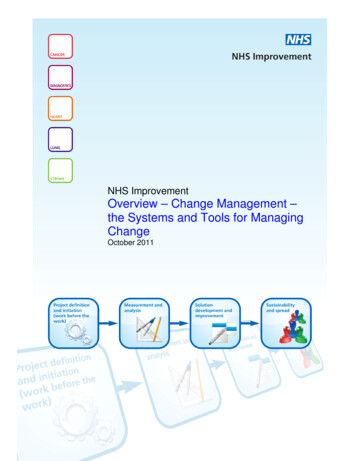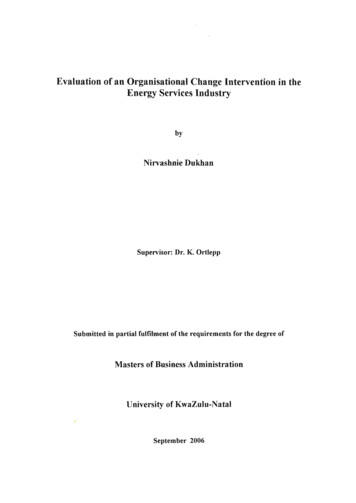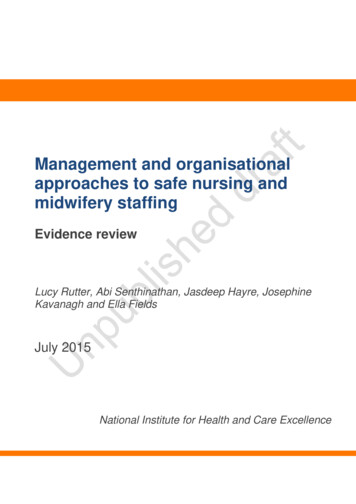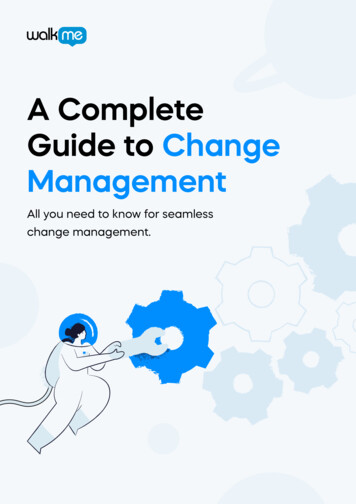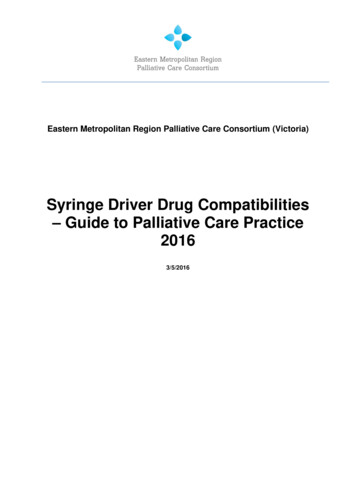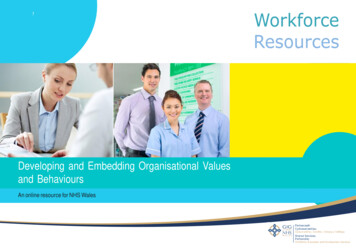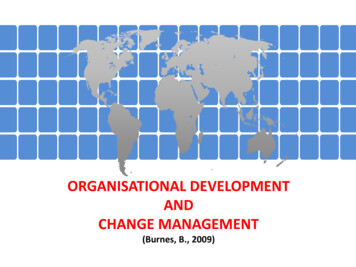
Transcription
ORGANISATIONAL DEVELOPMENTANDCHANGE MANAGEMENT(Burnes, B., 2009)
APPROACHESTOCHANGEMANAGEMENT
APPROACHES TO CHANGEMANAGEMENTThe biggest challenge is:understanding the strategy of the organisation andchoose the right approach andmanaging resistance to change
THEORETICAL FOUNDATIONSThe theory and practice of changemanagement draw on number ofsocial science disciplines andtraditions – schools of thoughtsIndividual PerspectiveSchoolGroup DynamicsSchoolOpen SystemsSchool
THEORETICAL FOUNDATIONS OF CHANGE MANAGEMENT(Limited to three Schools of ehaviour result of individuals’interaction with theirenvironment – all behaviour islearnt; individual is passiverecipient of external dataGestalt-Field Psychologists:Individual’s behaviour is theproduct of environment andreason – changeunderstanding of yourself andthe situation would lead tochange in behaviourGroupDynamicsSchoolOrganisational change takesplace through teams/workgroups rather thanindividualsChange the behaviouraccording to prevailingpractices and norms – Whatare the roles, norms &values hold by groupsOpen SystemsSchoolOrganisations is composed ofnr of interconnected subsystemsAny change on the part of thesystem will have impact onother parts of the systemIt is about achieving overallperformance and synergy.Collectively pursue overallbusiness objectivesUnderstanding the org in itsentirety
INDIVIDUAL PERSPECTIVE SCHOOLBEHAVIOURISTSGESTALT-FIELD PSYCHOLOGISTSindividuals interaction with the environment Individuals behaviour is the product ofenvironment and reasonAll behaviours is learnedLearning is a process of gaining/changinginsights, thoughts, outlooks, expectationsIndividual is a passive recipient of externaland objective data – human beings onlyrespond to external stimuli(Pavlov taught dog to salivate at the ringingof bell. Conditioning the dog to associatesound of bell with food)Focus on interpretation people place onactions and response- Believe a person function as a whole ,total organism- Each person possess positive andnegative characteristicsHuman actions are conditioned by theirexpected consequencesIndividual use reason to interpret stimuliBehaviour rewarded will be repeated andbehaviour ignored will stopIndividual should change theirunderstanding of themselves and situation To change behaviour, change also conditions - this would lead to change in behaviour- Achieve organisational change to throughthat causes it (Skinner)changing external stimuli acting upon theReward all instances of wanted behaviourindividual
GROUP DYNAMIC SCHOOL People in organisations work in teams, work groups rather than individuals Organisational change takes place through teams/work groups rather thanindividuals Change the behaviour of individual according to group’s prevailing practices andnorms Individual behaviour is a function of the group environment Group is in a continuous process of mutual adaptation Focus change at the group level and concentrate on influencing and changinggroup’s roles, norms & values hold by groups
OPEN SYSTEMS SCHOOLThe main perspective of Open System school and its objective: It makes references to organisation and its entirety It see organisation as composed of a number of interconnected sub-systems Any change in one part have an impact on other parts of system and overall performance Based on a method of describing and evaluating these sub-systems to determine howthey need to be changed to improve organisation’s overall functioning Systems in organisation are seen as open – not in isolation Open to interact with its external environment Open internally – various sub-systems interact with each other Internal changes in one area affect other areas and impact external environment and viceversaObjective:- structure the functions of business in such a way that clearly defined lines of coordinationand interdependence, the overall business objectives are collectively pursued.- Emphasis is on achieving overall synergy, rather than on optimizing the performance ofany one individual part.
FOUR PRINCIPAL ORGANIZATIONAL SUB-SYSTEMSOrganisational- Comprises of org’s stated objectives and values it wishes to promotegoals and valuesand achieve- To operate effectively, org must ensure that its objectives and valuessub-systemare COMPATIBLE with internal and external environmentTechnicalsub-system- Combination of knowledge, techniques and technologies required fororganisation to function effectively- Must be COMPATIBLE & APPROPRIATE to organisations circumstancesPsychosocialsub-system- Organisational climate and organisational culture- Fabric of values, relationships, values and norms that binds peopletogether and make them citizens organisation- It is influenced by org’s environment, history, employees, tasks,technology and structuresManagerialsub-system:-Relating an organisation to its environment,Setting goals, determining values,Developing comprehensive strategic and operational plans,Designing structures and establishing controlDirecting organisation and ensure objectives are achievedIf all these fails, the rest of organisation will fail
Three (3) factors that inform the Open school systemSub-system are interdepend:Alterations in one part of organisation therest of the organisationTraining is a mechanism of change andcannot succeed on its own.Attempting to change individual might notchange the organisation – consider othersub-systems To be successful, organisation must tap and direct the energy and talentof their workforce Remove obstacles preventing it and provide positive reinforcementwhich promotes it. Change norms, rewards, systems, structures etc. from organisationalperspective – rather than individual or group perspective
PLANNED APPROACH: KURT LEWIN Planned change: Identify areas needing change, evaluate & bring about changePlanned approach to change is closely associated to the practice of OD (its core)Concern about resolving conflicts and democratic valuesBelieved in Improved human conditionsFirst identify restraining forces, understand group behaviour, map complexity inwhich behaviour take placeLook at the present status quoIdentify driving forces that should be diminished or strengthenedDetermine why people behave the way they doLook at group dynamics (how groups shape behaviour of its membersWhat is the nature or characteristics of each groupThree-step model: unfreeze the present (inability to change), moving (createsmotivation to learn or adapt) and refreeze (stabilize new behaviour)People react and adjust when faced with changeCoping cycle: five stages: denial – need for change, defence past practices,discarding past behaviour to adjust, adapt to new ways and internalisation(change seen as normal).
PHASES OF PLANNED CHANGE (Bullock & Batten) Organisation exist in different states – go through differentprocesses and change should be planned in different states Exploration phase: determine need for change – consultants? Planning phase: Plan the change, collect information, diagnosis of problem,determine appropriate actions etc. Action phase: Move the oranisation from the current to desired future state,manage change process, gain support, evaluate implementation activities Integration phase: After successful implementation, stabilize change to be partof organisation’s normal, everyday operations (refreeze); reinforcementthrough feedback and reward
THREE MODELS OF CHANGE MANAGEMENT-Incrementalmodel of change-Punctuatedequilibrium modelof ionmodel of change-Individual parts of an org deal incrementally and separately withone problem and one goal at a timeIt takes long time to change – “muddling through with purpose”Managers who respond to pressures in their environments, over atime, their organisations become transformedChange takes place through successive, limited & negotiated shiftsOrganisations evolve through long periods of stability (equilibriumperiods) that are punctuated by relatively short burst offundamental change (revolutionary periods)Revolutionary periods disrupt established activity patterns andinstall the basis for new equilibrium periodsPunctuate : occur at intervals – discontinuities by modificationsTo survive organisations must develop ability to changethemselves continuously in a fundamental mannerChange pattern is endless modifications in work processes andsocial practicesEnvironment in which organisation operate is changing, and willcontinue to change, rapidly, radically and unpredictably
ORGANISATIONAL CHANGE AND MANAGERIAL CHOICE Central to change process is the is the choice process:-what to changewhen to changehow to change Change comes in wide variety of shapes and sizesTherefore, corresponding approaches to strategy development and changemanagement are neededConsider the nature of environment in which organisation operatesPlanned approach: assume that environment is relatively stable, predictable,controllableEmergent approach: assume that environment is turbulent, unpredictable anduncontrollablePrincipal role of managers and the objective of strategy and change is to alignor realign an organisation with its environment
THE CHOICE MANAGEMENT-CHANGE MANAGEMENT MODELOrganisational change is viewed as theproduct of three interdependentorganisational processesThe choice process(concerned with nature, scope and focusof organisational decision-making)The trajectory process(it relates to org’s past & futuredirection - is the outcome of it’s vision,purpose & future objectives)The change process(Approaches to changeMechanisms of achieving changeOutcomes of change)There are groups of elements or forces which interact, clash with and influence each other in subtle orcomplex ways. All these can have an impact on the decision-making and change management process.
THE CHOICE PROCESSOrgContext- Org should know their strengths /weaknesses, customer needs, nature ofenvironment in which they operate- Collect info on past, present and anticipated future performance- Collect info on main internal constraints such as structures, culture, politics,management style- Collect info on main external constraints such as industry, sector norms, businessenvironment- Tools to used: SWOT analysis & PESTEL (Political, Economic, Socio-cultural,Technological, Environmental & Legal)- Benchmark org’s performanceFocus ofchoice- Focus on key activities of success and aligning it self- Focus on influencing or changing constraints under which it operates- Short-term, medium or long-term focus for decision-making- Trajectory/direction is shaped by its past actions, future objectives andOrgtrajectory strategies(direction) - Determine interplay between org’s vision, strategies & approach to change- Trajectory is also a blend or clash between emergent elements of its strategy- Interpretation of past actions and future intent – ability to shape developingevents
THE TRAJECTORY PROCESS-Organisational Vision:Use various visioning techniques to get different futures and realities to select mostfavourable oneNot all visions lead to success – create ambitious visionsComprise of mission, valued outcomes, valued conditions, mid-point goals -Organisational Strategy:Stream of actions taken to move towards visionThese could be planned, driven, delegated and distributed throughout organisationMust have formal and informal plans as well as planned and unplanned actions -Organisational Change:Create conditions in which change placesIts only through change that vision and strategy can advance and become reality -
THE CHANGE PROCESSObjectives &outcomesTrigger: investigate need for change – current performanceRemit: Reasons for assessment, objectives, timeline, who should be involvedAssessment Team:- Assess need for change- Representatives from areas affected, change specialistAssessment: Clarify and amend remit. Team should:- Clarify problem- Investigate alternative solutions- Feedback- Recommendations/decisionPlanning thechange-Establish change management teamManagement structures (in the project)Activity planningCommitment planning (key people, how to gain support)Audits and post-audits (monitor progress)Training and development (new skills/competencies needed)People-Create willingness to changeMake people aware of pressuresUnderstand peoples’ fears and concernsGive regular feedback of performanceInvolve people (communication and involvement)Sustain momentum (provide resources, support, develop new skills,reinforced desired behaviour)
Three (3) factors that inform the Open school system . Sub-system are interdepend: Alterations in one part of organisation the rest of the organisation To be successful, organisation must tap and direct the energy and talent of their workforce Remove obstacles preventing it and provide positive reinforcement which promotes it.
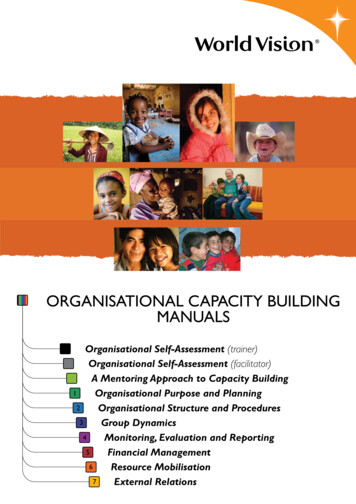

![Change Management Process For [Project Name] - West Virginia](/img/32/change-20management-20process-2003-2022-202012.jpg)

